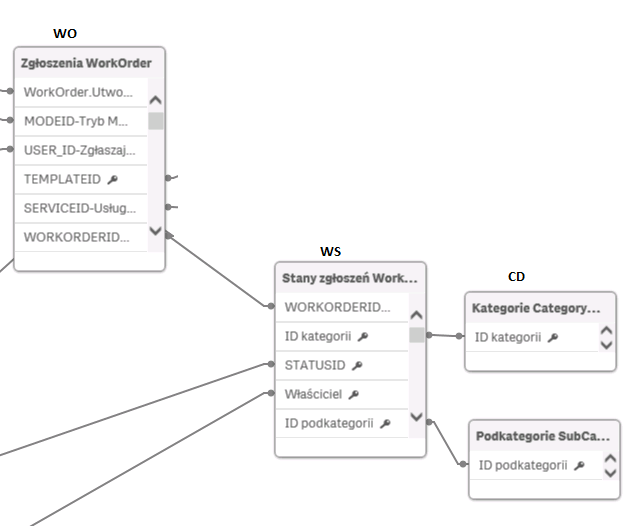Unlock a world of possibilities! Login now and discover the exclusive benefits awaiting you.
- Qlik Community
- :
- Forums
- :
- Analytics
- :
- New to Qlik Analytics
- :
- Include null in KPI set analysis expression
- Subscribe to RSS Feed
- Mark Topic as New
- Mark Topic as Read
- Float this Topic for Current User
- Bookmark
- Subscribe
- Mute
- Printer Friendly Page
- Mark as New
- Bookmark
- Subscribe
- Mute
- Subscribe to RSS Feed
- Permalink
- Report Inappropriate Content
Include null in KPI set analysis expression
Hello,
I have following query
select count(wo.WORKORDERID)
from workorder wo
left join ws….
left join cd….
where (ws.ISOVERDUE=1)
and ((cd.CATEGORYNAME = 'AA')
OR (cd.CATEGORYNAME = 'BB')
OR (cd.CATEGORYNAME IS NULL));
I want to write KPI based on above query. KPI is OK when I count:
Count({$< [ISOVERDUE]={'1'}, CATEGORYNAME ={'AA','BB'}>} Distinct WORKORDERID)
But this version is wrong:
Count({$< [ISOVERDUE]={'1'}, CATEGORYNAME ={'AA','BB', IsNull}>} Distinct WORKORDERID)
I have tried also these versions below and they are wrong too:
Count({$< [ISOVERDUE]={'1'}, CATEGORYNAME ={'AA','BB'}> + < [ISOVERDUE]={'1'}, WORKORDERID={'=Len(Trim(CATEGORYNAME))=0'}>} Distinct WORKORDERID)
Count({$< [ISOVERDUE]={'1'}, CATEGORYNAME ={'AA','BB'}> + < [ISOVERDUE]={'1'}, CATEGORYNAME ={'-'}>} Distinct WORKORDERID)
Count({$< [ISOVERDUE]={'1'}, CATEGORYNAME ={'AA','BB'}> + < [ISOVERDUE]={'1'}, CATEGORYNAME -={'*'}>} Distinct WORKORDERID)
How to include null or blank values in KPI calculation?
- « Previous Replies
-
- 1
- 2
- Next Replies »
- Mark as New
- Bookmark
- Subscribe
- Mute
- Subscribe to RSS Feed
- Permalink
- Report Inappropriate Content
How about this
Count({$<[ISOVERDUE] = {'1'}, WORKORDERID = {"=Match(CATEGORYNAME, 'AA', 'BB') or Len(Trim(CATEGORYNAME)) = 0"}>} DISTINCT WORKORDERID)
- Mark as New
- Bookmark
- Subscribe
- Mute
- Subscribe to RSS Feed
- Permalink
- Report Inappropriate Content
Thank you Sunny, great help, I will werify it soon.
Now I would like to add to my count more conditions.
Query will look like below:
select Count(wo.WORKORDERID)
from workorder wo
left join ws….
left join cd….
where (ws.ISOVERDUE=1)
AND((cd.CATEGORYNAME = 'AA')
OR (cd.CATEGORYNAME = 'BB')
OR (cd.CATEGORYNAME IS NULL))
AND ((QUEUENAME != ‘FACIL')
AND (QUEUENAME != 'WATTO')
AND (QUEUENAME != 'HELP')
OR (QUEUENAME IS NULL));
Combining your answear and my new conditions KPI may look as below:
Count({$<[ISOVERDUE] = {'1'}, WORKORDERID = {"=Match(CATEGORYNAME, 'AA', 'BB') or Len(Trim(CATEGORYNAME)) = 0"}>*
(< [QUEUENAME]-={'FACIL'}, [QUEUENAME]-={'WATTO'}, [QUEUENAME]-={'HELP'}>+<[QUEUENAME]={IsNull}>)
} DISTINCT WORKORDERID)
but again it is something wrong.
Can I somehow implement Match function for new condition or is another way to solve it?
- Mark as New
- Bookmark
- Subscribe
- Mute
- Subscribe to RSS Feed
- Permalink
- Report Inappropriate Content
May be just do this again within the same WORKORDERID modifier
Count({$<[ISOVERDUE] = {'1'}, WORKORDERID = {"=(Match(CATEGORYNAME, 'AA', 'BB') or Len(Trim(CATEGORYNAME)) = 0) and (not Match(QUEUENAME, 'FACIL', 'WATTO', 'HELP') or Len(Trim(QUEUENAME)) = 0)"}>} DISTINCT WORKORDERID)
- Mark as New
- Bookmark
- Subscribe
- Mute
- Subscribe to RSS Feed
- Permalink
- Report Inappropriate Content
It works regarding MATCH() but it doen's work regarding Len(Trim()).
I have simplified query and KPI for easier analysis.
Query looks as below and gives around 60 records from my DB:
select Count(wo.WORKORDERID)
from workorder wo
left join ws on …
left join cd on …
where (ws.ISOVERDUE=1)
and (cd.CATEGORYNAME IS NULL);
KPI looks as below and it counts over 1200 records:
Count({$< [ISOVERDUE]={'1'}, WORKORDERID={"= Len(Trim(CATEGORYNAME)) = 0"}>} Distinct WORKORDERID)
- Mark as New
- Bookmark
- Subscribe
- Mute
- Subscribe to RSS Feed
- Permalink
- Report Inappropriate Content
The only thing I see a little different is that your where clause include fields which are from other tables (ws and cd)... are you left joining these tables in your app? If not, can you check what this gives?
Count(DISTINCT If([ISOVERDUE] = 1 and Len(Trim(CATEGORYNAME)) = 0, WORKORDERID)
- Mark as New
- Bookmark
- Subscribe
- Mute
- Subscribe to RSS Feed
- Permalink
- Report Inappropriate Content
The count:
Count(DISTINCT If([ISOVERDUE] = 1 and Len(Trim(CATEGORYNAME)) = 0, WORKORDERID)
gave 1260 records.
Below is part of the data model from model viewer with appropriate tables:

- Mark as New
- Bookmark
- Subscribe
- Mute
- Subscribe to RSS Feed
- Permalink
- Report Inappropriate Content
Very difficult to say... would you be able to share a sample?
- Mark as New
- Bookmark
- Subscribe
- Mute
- Subscribe to RSS Feed
- Permalink
- Report Inappropriate Content
why did use the "=" before the first match( which is logical to me) and did not proceed with same logic with the len(trim()) part?
- Mark as New
- Bookmark
- Subscribe
- Mute
- Subscribe to RSS Feed
- Permalink
- Report Inappropriate Content
Is this for me? I am sorry, I am not sure what you are asking?
- « Previous Replies
-
- 1
- 2
- Next Replies »